एनकोडर और डिकोडर कैसे काम करता है? यह समझने से पहले जरूरी है की, हम यह समझें की इनकी जरूरत क्या है? देखिये, Encoder हो या Decoder, दोनों का सबसे ज्यादा उपयोग communication system के transmitter और receiver में किया जाता है, security के उद्देदश्य से. Security से मतलब यह है की मान लीजिये, किसी ने आपको कोई secret code भेजा, लेकिन, security reason की वजह से आप नहीं चाहते की आपका वह code किसी तीसरे व्यक्ति तक पहुंचे या वह उस code को समझ पाये।
इसीलिए, Transmitter में Encoder को प्रयोग किया जाता है, जो original information को एक coded form में बदल देता है. इस Process को Encryption कहते हैं. अब एनकोडर द्वारा coded form को, कोई third party क्या, receiver भी नहीं समझ सकता है. इसके लिए जरूरत पड़ती है, Decoder की.
डिकोडर, एनकोडर द्वारा coded की गयी information को original form में convert करता है. इस process को Decryption कहते हैं. आइये, अब समझते हैं की Digital Electronics में Decoder Kya Hai, Yeh kitne prakar ka hota hai aur kaise kaam karta hai?
Also Read: Multiplexer Kya Hai?
जिस तरीके से Encoder, data को coded form में convert करता है. उसी प्रकार, decoder, encoder द्वारा की गयी coded form को decode यानी data का original form करता है.
डिकोडर क्या है? | What is Decoder in Hindi?
Encoder की तरह Decoder भी एक combinational circuit है. यह n input lines से data को receive करता है, और 2n output lines produce करता है.

डिकोडर कितने प्रकार के होते हैं? | How Many Types of Decoder in Hindi?
1) 1 × 2 Decoder
2) 2 × 4 Decoder
3) 3 × 8 Decoder
4) 4 × 16 Decoder
यह सभी डिकोडर Binary Decoder भी कहलाते हैं.
Also Read
- Hexadecimal Number Kya Hota Hai?
- Basic Laws of Boolean Algebra in Hindi
- Decimal Number Kya Hota Hai?
- Adder aur Subtractor Kya Hai?
1) 1:2 Decoder
इस Decoder में केवल एक input line होती है, और यह 2-output line produce होती है.

Truth Table of 1:2 Decoder
| I | D1 | D0 |
| 0 | 0 | 1 |
| 1 | 1 | 0 |
Truth-table को देखिये, D0 bit तब transfer हुई, जब input signal I=0 था. वहीं, जब I=1 था, तब D1 bit ट्रांसफर हुई. ऊपर लिखी गयी Truth-table की मदद से, D0 और D1 expression को कुछ इस प्रकार लिख सकते हैं.
D0 = I’
D1 = I
आइये, इन equations को logic gate की मदद से implement करते हैं,
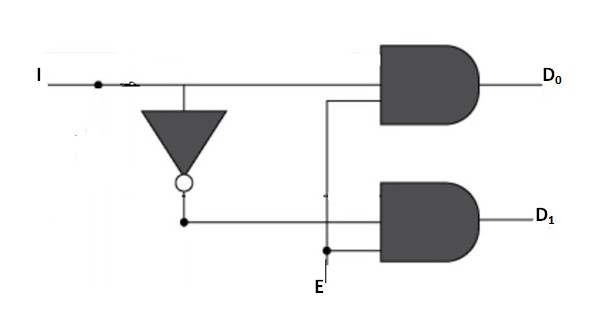
2) 2:4 Decoder
इस decoder में 2 input lines होती हैं, जो की 4-output lines produce करती हैं.
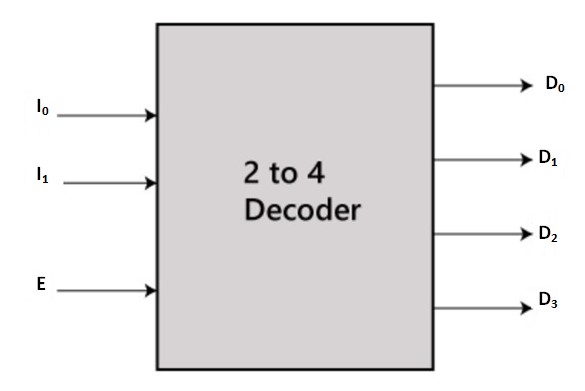
Truth-Table of 2:4 Decoder
| I0 | I1 | D0 | D1 | D2 | D3 |
| 0 | 0 | 1 | 0 | 0 | 0 |
| 0 | 1 | 0 | 1 | 0 | 0 |
| 1 | 0 | 0 | 0 | 1 | 0 |
| 1 | 1 | 0 | 0 | 0 | 1 |
जैसा 1:2 decoder में equation लिखी थी, बिल्कुल वैसे ही 2:4 decoder (D0, D1, D2 और D3) के लिए भी equation लिखते हैं.
देखिये, D0 ‘1’ कब हुआ, जब I0 और I1 ‘0’ थे, तो इसका expression कुछ इस प्रकार लिखा जा सकता है.
D0 = I0‘ . I1‘
इसी प्रकार, D1, D2, और D3 के expression लिख लेते हैं,
D1 = I0‘.I1
D2 = I0.I1
D3 = I0.I1
आइये, अब लॉजिक गेट्स की मदद से D0, D1, D2 और D3 के expression को implement करते हैं.
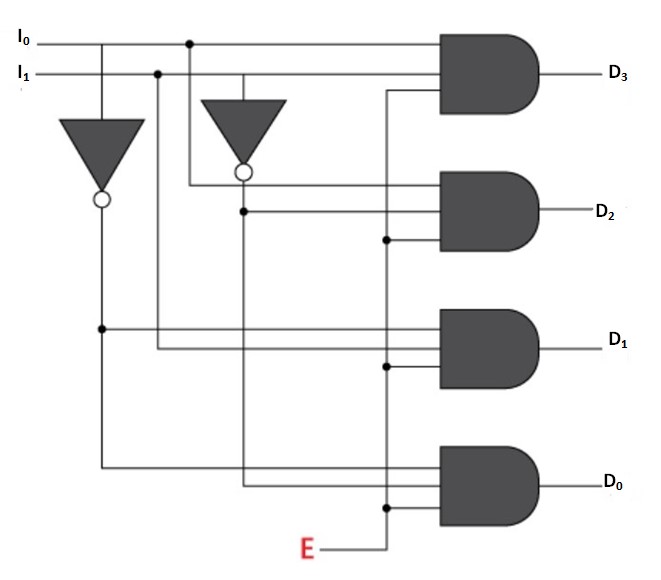
3) 3:8 Line Decoder
इस decoder को binary to octal decoder भी कहते हैं. इस decoder में 3-input lines और 8-output lines (D0, D1, D2, D3, D4, D5, D6 D7 ) होती है.
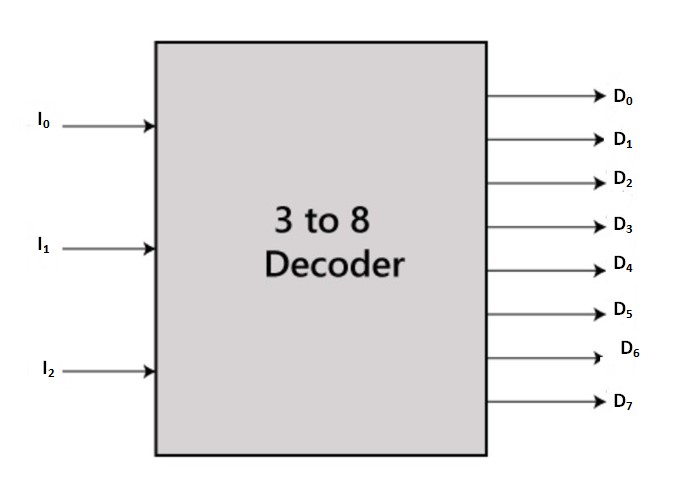
Truth-table of 3×8 Decoder
| I0 | I1 | I2 | D0 | D1 | D2 | D3 | D4 | D5 | D6 | D7 |
| 0 | 0 | 0 | 1 | 0 | 0 | 0 | 0 | 0 | 0 | 0 |
| 0 | 0 | 1 | 0 | 1 | 0 | 0 | 0 | 0 | 0 | 0 |
| 0 | 1 | 0 | 0 | 0 | 1 | 0 | 0 | 0 | 0 | 0 |
| 0 | 1 | 1 | 0 | 0 | 0 | 1 | 0 | 0 | 0 | 0 |
| 1 | 0 | 0 | 0 | 0 | 0 | 0 | 1 | 0 | 0 | 0 |
| 1 | 0 | 1 | 0 | 0 | 0 | 0 | 0 | 1 | 0 | 0 |
| 1 | 1 | 0 | 0 | 0 | 0 | 0 | 0 | 0 | 1 | 0 |
| 1 | 1 | 1 | 0 | 0 | 0 | 0 | 0 | 0 | 0 | 1 |
Truth-table में देखिये, D0 कब ‘1’ हुआ, जब I0, I1, और I2 ‘0’ थे.
यानी D0 = I0‘. I1‘. I2‘
इसी प्रकार, D1, D2, D3, D4, D5, D6, D7 के expression लिखेंगे,
D1 = I0‘.I1‘.I2
D2 = I0‘.I1. I2‘
D3 = I0‘. I1.I2
D4 = I0.I1‘.I2‘
D5 = I0.I1‘.I2
D6 = I0.I1.I2‘
D7 = I0.I1.I2
आइये, अब इन expressions को logic gate की help से implement करते हैं.
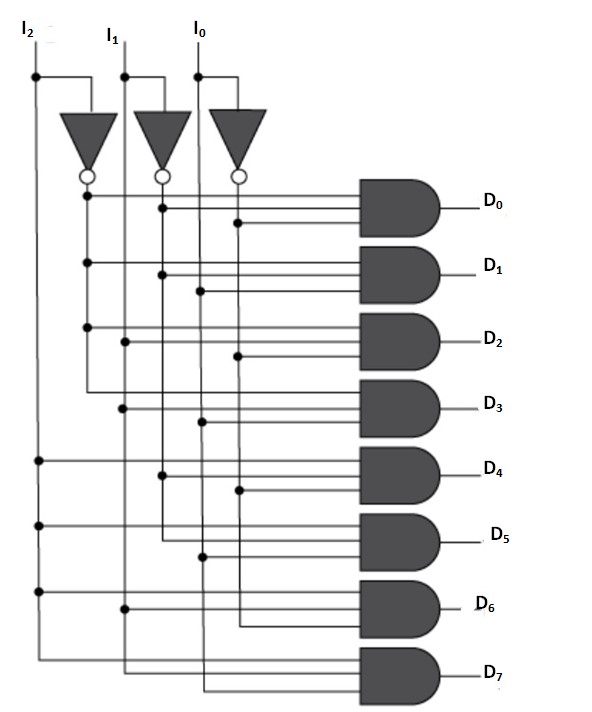
4) 4:16 Line Decoder
जैसा की पिछले decoders में हमने पढ़ा, उसी प्रकार इस decoder में 4-input line और 16-output lines produce होती हैं. नीचे बने चित्र को देखें,
मैं चाहूंगी की इस truth-table की मदद से expression को आप खुद drive करें और खुद ही logic gates की मदद से implement करें। यदि आपको समझ नहीं आता है, या आप implement नहीं कर पाते हैं, तो comment box में लिखें, हम आपको इसका उत्तर समझायेंगे।
Applications of Decoder in Hindi
1) Decoder का उपयोग code conversion में किया जाता है. जैसे- analog to digital conversion
2) Data distribution (demultiplexing) में decoder का उपयोग किया जाता है.
3) Memory में डिकोडर का उपयोग होता है, जिस से performance यानी speed increase होती है.
4) Microprocessor में इसका उपयोग input-output devices को select करने के लिये किया जाता है.
एनकोडर और डिकोडर में क्या अंतर है? | Difference Between Encoder and Decoder in Hindi
|
Encoder |
Decoder |
| Encoder किसी भी इनफार्मेशन को डिजिटल इनपुट सिगनल (यानी code form) में convert करता है. | जबकि decoder coded information को original input information में convert करता है. |
| Encoder में 2n input दिये जाते हैं. | जबकि डिकोडर में n इनपुट दिए जाते हैं. |
| एनकोडर में n output lines produce होती हैं. | जबकि decoder, 2n output lines produce करता है. |
| एनकोडर सर्किट, transmitting end पर establish किया जाता है. | जबकि डिकोडर सर्किट receiving end पर install किया जाता है. |
| एनकोडर का सबसे ज्यादा प्रयोग Email और video encoder में किया जाता है. | जबकि decoder का प्रयोग memory और माइक्रोप्रोसेसर में किया जाता है. |
| Encoder के designing में OR gate एक basic element होता है. | जबकि decoder की designing में AND gate और NOT gate एक basic element होता है. |
डिकोडर और डीमल्टीप्लेक्सर में क्या अंतर है? | What is the Difference between Decoder and Demultiplexer?
1) Decoder encrypted signal को decrypt करता है. जबकि Demultiplexer, single input signal को multiple signal में convert करता है.
2) Decoder में n input lines और 2n output lines होती हैं,जबकि Demux में n selection lines और 2n output lines होती हैं.
3) डिकोडर का सबसे ज्यादा उपयोग नेटवर्किंग में किया जाता है, जबकि Demux का उपयोग data-routing की applications में किया जाता है.
आशा करती हूँ की इस आर्टिकल में आपको Decoder से जुडी सारी जानकारी मिली होगी। यदि आपको यह आर्टिकल अच्छा लगे, तो अपने दोस्तों और मित्रों के साथ शेयर करें, और अगर आपका कोई प्रश्न हो तो आप comment box में पूछ सकते हैं.
